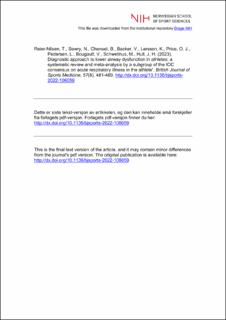| dc.contributor.author | Reier-Nilsen, Tonje | |
| dc.contributor.author | Sewry, Nicola | |
| dc.contributor.author | Chenuel, Bruno | |
| dc.contributor.author | Backer, Vibeke | |
| dc.contributor.author | Larsson, Kjell | |
| dc.contributor.author | Price, Oliver J. | |
| dc.contributor.author | Pedersen, Lars | |
| dc.contributor.author | Bougault, Valerie | |
| dc.contributor.author | Schwellnus, Martin | |
| dc.contributor.author | Hull, James H. | |
| dc.date.accessioned | 2023-05-10T06:41:51Z | |
| dc.date.available | 2023-05-10T06:41:51Z | |
| dc.date.created | 2023-03-07T18:18:16Z | |
| dc.date.issued | 2023 | |
| dc.identifier.citation | British Journal of Sports Medicine. 2023, 57(8), 481-489. | en_US |
| dc.identifier.issn | 0306-3674 | |
| dc.identifier.uri | https://hdl.handle.net/11250/3067394 | |
| dc.description | I Brage finner du siste tekst-versjon av artikkelen, og den kan inneholde ubetydelige forskjeller fra forlagets pdf-versjon. Forlagets pdf-versjon finner du på bjsm.bmj.com / In Brage you'll find the final text version of the article, and it may contain insignificant differences from the journal's pdf version. The original publication is available at bjsm.bmj.com | en_US |
| dc.description.abstract | Objectives: To compare the performance of various diagnostic bronchoprovocation tests (BPT) in the assessment of lower airway dysfunction (LAD) in athletes and inform best clinical practice. Design: Systematic review with sensitivity and specificity meta-analyses. Data sources: PubMed, EBSCOhost and Web of Science (1 January 1990–31 December 2021). Eligibility criteria: Original full-text studies, including athletes/physically active individuals (15–65 years) who underwent assessment for LAD by symptom-based questionnaires/history and/or direct and/or indirect BPTs. Results: In 26 studies containing data for quantitative meta-analyses on BPT diagnostic performance (n=2624 participants; 33% female); 22% had physician diagnosed asthma and 51% reported LAD symptoms. In athletes with symptoms of LAD, eucapnic voluntary hyperpnoea (EVH) and exercise challenge tests (ECTs) confirmed the diagnosis with a 46% sensitivity and 74% specificity, and 51% sensitivity and 84% specificity, respectively, while methacholine BPTs were 55% sensitive and 56% specific. If EVH was the reference standard, the presence of LAD symptoms was 78% sensitive and 45% specific for a positive EVH, while ECTs were 42% sensitive and 82% specific. If ECTs were the reference standard, the presence of LAD symptoms was 80% sensitive and 56% specific for a positive ECT, while EVH demonstrated 65% sensitivity and 65% specificity for a positive ECT. Conclusion: In the assessment of LAD in athletes, EVH and field-based ECTs offer similar and moderate diagnostic test performance. In contrast, methacholine BPTs have lower overall test performance. | en_US |
| dc.language.iso | eng | en_US |
| dc.subject | asthma | en_US |
| dc.subject | athletes | en_US |
| dc.subject | diagnosis | en_US |
| dc.subject | exercise test | en_US |
| dc.subject | respiratory system | en_US |
| dc.title | Diagnostic approach to lower airway dysfunction in athletes: a systematic review and meta-analysis by a subgroup of the IOC consensus on acute respiratory illness in the athlete' | en_US |
| dc.title.alternative | Diagnostic approach to lower airway dysfunction in athletes: a systematic review and meta-analysis by a subgroup of the IOC consensus on acute respiratory illness in the athlete' | en_US |
| dc.type | Peer reviewed | en_US |
| dc.type | Journal article | en_US |
| dc.description.version | acceptedVersion | en_US |
| dc.source.pagenumber | 10 | en_US |
| dc.source.journal | British Journal of Sports Medicine | en_US |
| dc.identifier.doi | 10.1136/bjsports-2022-106059 | |
| dc.identifier.cristin | 2132109 | |
| dc.description.localcode | Institutt for idrettsmedisinske fag / Department of Sports Medicine | en_US |
| cristin.ispublished | true | |
| cristin.fulltext | postprint | |
| cristin.qualitycode | 2 | |
